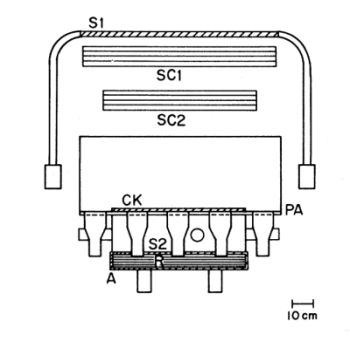Purpose of the flight and payload description
IRIS (IRon ISotopes) was a balloon-borne experiment aimed to measure the isotopic composition of iron nuclei in the cosmic radiation that employed a then new combination of active electronic counters to measure particle speed, trajectory, and charge, and a passive polycarbonate plastic stack to measure range. The instrument was designed and constructed by the Department of Physics of the University of California, Berkeley.
A cross section of the IRIS telescope appears in the figure at left (click to enlarge). Range was measured with a stack, labeled R, consisting of 330 sheets of Lexan polycarbonate plastic track detector each 127 µm thick. Particles which stoped in the range stack were identified with events observed in the active detectors using trajectory information provided by optical spark chambers SCI and SC2. The long lever arm between the spark chambers and the range stack enabled a precise determination of trajectory used in correcting the detector pulse heights and range measurement. A passive aluminum absorber labeled PA provided a uniform nonhydrogenous material in which a large part of the slowing took place. Organic plastic scintillators SI and S2 were used to measure energy loss, and to define the geometry of the instrument. An anticoincidence scintillator, labeled A, eliminated from analysis penetrating particles (for which no range measurement was possible) and particles which suffered nuclear interactions in the telescope, creating light, highly penetrating, charged fragments.
A large-area, precision Cerenkov detector, labeled CK, was used in conjunction with the scintillation measurements to determine particle charge and speed. Mass was determined from the range measurement using range-energy formulae.
The instrument was sealed in a pressurized and insulated aluminum shell.
Details of the balloon flight
Balloon launched on: 9/13/1976
Launch site: Watertown Municipal Airport, South Dakota, US
Balloon launched by: Raven Ind.
Balloon manufacturer/size/composition: Zero Pressure Balloon 26.000.000 cuft
Flight identification number: 1393
End of flight (L for landing time, W for last contact, otherwise termination time): 9/14/1976
Balloon flight duration (F: time at float only, otherwise total flight time in d:days / h:hours or m:minutes - ): 25 h
The balloon was launched from Watertown, South Dakota on September 13, 1976, remaining in flight for more than 25 hours at an altitude of ~3.4 g/cm2 of residual atmosphere.
During the flight A total of 1622 events triggered the coincidence logic. Of these, 1505 produced acceptable tracks in the spark chambers.
External references
- A measurement of the cosmic-ray source abundance of Ca-40 Astrophysical Journal, Part 2 - Letters to the Editor, vol. 232, Sept. 15, 1979, p. L161-L164.
- Bevalac calibrations and preliminary balloon flight results of an experiment to measure the isotopic composition of iron and nickel in the cosmic rays International Cosmic Ray Conference, 17th, Paris, France, July 13-25, 1981, Conference Papers. Volume 2 p. 85
- Cosmic ray isotope abundances from chromium to nickel Astrophysical Journal, Part 1, vol. 230, June 1, 1979, p. 607-620
- Further analysis of the IRIS iron isotope experiment Conference Papers 16th International Cosmic Ray Conference, Kyoto, Japan, 1979, p. 455
- High resolution Cherenkov and range detectors for balloon-borne cosmic-ray experiment Nuclear Instruments and Methods, Vol. 136, p. 229 (1976)
- Measurement of the Isotopic Composition of the Iron-Group Elements in the Galactic Cosmic Radiation Physical Review Letters, Volume 41, Issue 11, September 11, 1978, pp.771
12782If you consider this website interesting or useful, you can help me to keep it up and running with a small donation to cover the operational costs. Just the equivalent of the price of a cup of coffee helps a lot.


